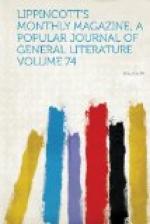pitiful object to behold. The pictures and engravings
of twenty years ago bear witness to the degree of
“wasting” to which a horse was reduced
on the eve of a race, and the caricatures of the period
are hardly over-drawn when they exhibit to us the ghost
of an animal mounted by a phantom jockey. When
people saw that Jennings was able to bring to the
winning-post horses in good condition, whose training
had been based upon nothing but regular work, they
at first looked on in astonishment, but afterward
found their profit in imitating his example.
Under this rational system it has been proved that
the animal gains in power and endurance while he loses
nothing in speed. The same intrepid trainer has
ventured upon another innovation. Impressed with
the inconveniences of shoeing, and annoyed by the
difficulty of finding a skilful smith in moving from
one place to another in the country, he conceived
the idea of letting his horses go shoeless, both during
training and on the track; and, despite all that could
be urged against the practice his horses’ feet
are in excellent condition. His many successes
on the turf have not, however, been crowned, as yet,
by the Grand Prix de Paris, though in 1877 he thought
to realize the dream of his ambition with Jongleur,
whom he had trained and whom he loved like a son;
and when the noble horse was beaten by an outsider,
St Christopher, “Old Hat” could not control
an exhibition of ill-humor as amusing as it was touching.
When Jongleur died Jennings wept for perhaps the first
time in his life, and he was still unable to restrain
his tears when he described the tortures of the poor
beast as he struck his head against the sides of his
box in the agonies of lockjaw.
Let us close our list—in which, however,
we have endeavored to enumerate only the principal
figures upon the French turf—with two names;
and first that of the young Edmond Blanc, heir to the
immense fortune gained by his late father as director
of the famous gaming-tables of Monaco. The latter,
like a prudent parent, forbade his son to race or
to play, and Edmond, obeying the letter of the law—at
least during the lifetime of his father—was
known, if known at all upon the course, under the
pseudonyme of James. At present, however, he
is the owner of an important stud and stable which
are constantly increasing, and which bid fair before
long to take rank amongst the principal establishments
in the country. Waggish tongues have whispered
that when he had to make choice of colors he naturally
inclined to “rouge et noir,” but finding
these already appropriated by M. Lupin, the representative
of “trente et quarante” was forced to content
himself with tints more brilliant perhaps, but less
suggestive. But let him laugh who wins.
The annals of the turf for 1879 inscribe the name
of M. Blanc as winner of the Grand Prix de Paris.
It was his mare, Nubienne, who first reached the winning-post
by a neck in a field of eleven horses, M. Fould’s
Salteador being second, with barely a head between
him and the third, Flavio II., belonging to the comte
Frederic de Lagrange.




